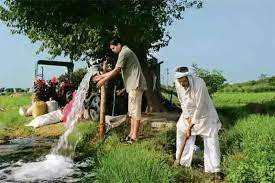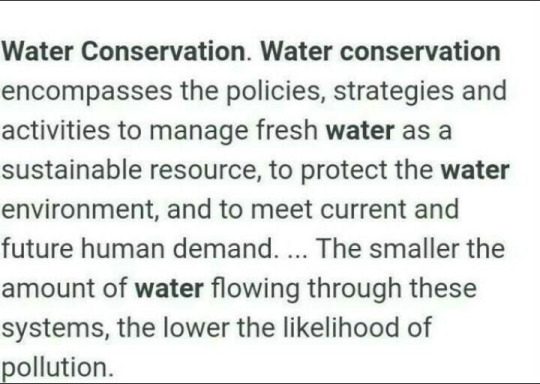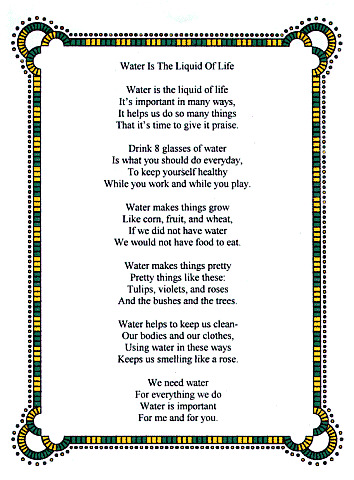Text
Regulating the Use of Groundwater

With a number of farmers drawing great quantities of water from a common source, a different strategy was needed than what prevailed during frontier days when settlers regulated and managed their own water supplies. A successful conservation program at this larger scale called for an enlarged regulatory and water management role. Government took up the challenge and intervened, and the politics of water conservation emerged.
Government regulation can be tricky business in Arizona. It is often viewed as intrusive and against the pioneering grain of the independent and self-sufficient settler, at least as this figure is understood in popular culture. For example, legislative hearings of 1947 regarding proposed groundwater legislation elicited the following remark from a farmer: "Who is going to tell me what to do and how to do it? If my land is destroyed through lack of water I want to destroy it myself; I don't want you to do it." This defiant statement expresses an attitude to contend with back then and to be considered even now, especially when regulation of natural resources is at issue.
By the early 1940s, various proposals were made in the Arizona Legislature, for studying, writing and passing a groundwater code. Realizing it was to its benefit, the agricultural sector took a special interest in the passage of a groundwater code, with the Arizona Farm Bureau Federation calling for a code as early as 1942. A U.S. Geological Survey study of major groundwater basins at this time provided further evidence of the need for legislative action. The agency found in one especially heavily developed area of the state the annual safe-yield was being exceeded by 18 times. Safe yield means a long-term balance between the amount of groundwater pumped each year and the natural and artificial recharge occurring annually.
-----------------------------------------------------------------------------
This text delves into the historical context of water management in Arizona, addressing the shift from frontier-style individual regulation to government intervention in response to the increasing demand for water by farmers.
The text provides a historical account of the evolution of water management in Arizona, outlining the conflict between individualism and government regulation. It emphasizes the tension between traditional values and the necessity for collective resource management.
The author highlights the complex dynamics of water resource regulation in Arizona, particularly in the face of opposition to government intervention. The text underscores the importance of addressing the growing strain on water resources.
The text indirectly suggests the need for a balanced approach to water resource management, where government regulation can be necessary to prevent overuse and preserve water supplies while respecting individual autonomy.
In conclusion, this text illustrates the historical struggle in Arizona to balance individualism and collective responsibility in water management. It underscores the imperative of addressing over-pumping of groundwater and the long-term sustainability of this vital resource.

1 note
·
View note
Text
Regulating the Use of Groundwater

With a number of farmers drawing great quantities of water from a common source, a different strategy was needed than what prevailed during frontier days when settlers regulated and managed their own water supplies. A successful conservation program at this larger scale called for an enlarged regulatory and water management role. Government took up the challenge and intervened, and the politics of water conservation emerged.
Government regulation can be tricky business in Arizona. It is often viewed as intrusive and against the pioneering grain of the independent and self-sufficient settler, at least as this figure is understood in popular culture. For example, legislative hearings of 1947 regarding proposed groundwater legislation elicited the following remark from a farmer: "Who is going to tell me what to do and how to do it? If my land is destroyed through lack of water I want to destroy it myself; I don't want you to do it." This defiant statement expresses an attitude to contend with back then and to be considered even now, especially when regulation of natural resources is at issue.
By the early 1940s, various proposals were made in the Arizona Legislature, for studying, writing and passing a groundwater code. Realizing it was to its benefit, the agricultural sector took a special interest in the passage of a groundwater code, with the Arizona Farm Bureau Federation calling for a code as early as 1942. A U.S. Geological Survey study of major groundwater basins at this time provided further evidence of the need for legislative action. The agency found in one especially heavily developed area of the state the annual safe-yield was being exceeded by 18 times. Safe yield means a long-term balance between the amount of groundwater pumped each year and the natural and artificial recharge occurring annually.
-----------------------------------------------------------------------------
This text delves into the historical context of water management in Arizona, addressing the shift from frontier-style individual regulation to government intervention in response to the increasing demand for water by farmers.
The text provides a historical account of the evolution of water management in Arizona, outlining the conflict between individualism and government regulation. It emphasizes the tension between traditional values and the necessity for collective resource management.
The author highlights the complex dynamics of water resource regulation in Arizona, particularly in the face of opposition to government intervention. The text underscores the importance of addressing the growing strain on water resources.
The text indirectly suggests the need for a balanced approach to water resource management, where government regulation can be necessary to prevent overuse and preserve water supplies while respecting individual autonomy.
In conclusion, this text illustrates the historical struggle in Arizona to balance individualism and collective responsibility in water management. It underscores the imperative of addressing over-pumping of groundwater and the long-term sustainability of this vital resource.

1 note
·
View note
Text
Water Conservation Article

This article explores the vital concept of water conservation, delving into its role in sustainable resource management, environmental protection, and the fulfillment of human water needs.
The article presents a clear and informative discussion about water conservation, utilizing straightforward language and factual information. It focuses on policy and strategies for safeguarding fresh water, highlighting the importance of reduced water flow in pollution prevention.
The author's message revolves around the urgency of implementing policies and practices to preserve and efficiently manage our fresh water resources, addressing both environmental concerns and the growing global demand for water.
The article advises the adoption of strategies and policies that reduce water consumption, emphasizing the importance of protecting water environments and ensuring a sustainable water supply to meet the needs of current and future generations.
In summary, this article underscores the critical importance of water conservation in maintaining a sustainable and healthy water supply, as well as protecting the natural environment. It advocates responsible water management as a necessity for our future.

0 notes
Text
Water is the liquid of life

This poem celebrates the significance of water as the "liquid of life" and emphasizes its vital role in our daily existence, touching on its impact on our health, nourishment, and the beauty it brings to our world.
The poem employs simple language and rhyme, making it accessible to a wide audience, likely targeting children. Its structure and repetition contribute to its didactic nature, serving as an educational piece.
The poem underscores the essential nature of water in our lives, aiming to educate and raise awareness about its various functions, from quenching thirst to sustaining agriculture and promoting cleanliness.
The poem encourages the consumption of sufficient water daily, maintaining personal hygiene, and acknowledging water's role in agriculture and beauty. It advocates responsible water use.
In three stanzas, this poem delivers a clear message about the importance of water in a straightforward, didactic style. It serves as a reminder to appreciate and conserve this life-giving resource.

0 notes
Text
Ancient Egypt Shadoof
Ancient Egypt is pioneer in many areas of technology. One
important thing that they had to tame is water, because of their necessity of getting
water they developed amazing systems of extracting water and taking advantage of the
floods. One of these systems is the shadoof. The shadoof, also spelled Shaduf, is a hand-
operated device for lifting water. The shadoof was a long tool on a seesaw type of
bottom, with a weight on one end and a bucket on the other. The bucket could be
lowered into the canal and filled with water. Then, the bucket could be rotated around to
the area in need of water. The ancient Egyptians used it to help move water from the
canal to the fields.

11 notes
·
View notes
Text
Ancient India baolis
The ancient India is an important part of the development of the
civilization as we know it nowadays. It has an interesting history that is full of a rich
culture and an incredible amount of engineering features, like their system of water
storage “baolis”. The baolis are mainly separated in two parts, a mainly tank, and a well.
In the main tank is filled up with the rainfalls and the via water drawn up from below
ground. The well extends deep into the ground to draw up ground water.

0 notes
Text
Mesopotamia Irrigation System
Mesopotamia is one of the most important ancient
civilizations of history, because of their innovations in politics but also in technology. One of
the most important developments of this civilization is their Irrigation system that we still use in
the modern world. To irrigate their land, they dug out large storage basins to hold water
supplies. Then they dug canals, human-made waterways, that connected these basins to a
network of ditches. These ditches brought water to the fields. To protect their fields from
flooding, farmers built up the banks of the Tigris and Euphrates.
Mesopotamia is one of the most important ancient
civilizations of history, because of their innovations in politics but also in technology. One of
the most important developments of this civilization is their Irrigation system that we still use in
the modern world. To irrigate their land, they dug out large storage basins to hold water
supplies. Then they dug canals, human-made waterways, that connected these basins to a
network of ditches. These ditches brought water to the fields. To protect their fields from
flooding, farmers built up the banks of the Tigris and Euphrates.
Mesopotamia is one of the most important ancient
civilizations of history, because of their innovations in politics but also in technology. One of
the most important developments of this civilization is their Irrigation system that we still use in
the modern world. To irrigate their land, they dug out large storage basins to hold water
supplies. Then they dug canals, human-made waterways, that connected these basins to a
network of ditches. These ditches brought water to the fields. To protect their fields from
flooding, farmers built up the banks of the Tigris and Euphrates.

1 note
·
View note